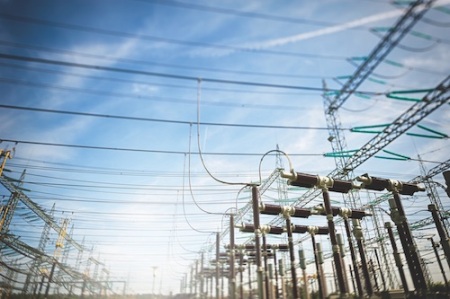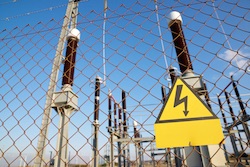Leaders from Britain’s energy industry attended Copa Data’s zenon Energy Day 2018 at the Thames Valley Microsoft centre. The event, which was held on in April 2018, welcomed industry experts and energy suppliers to address the current challenges the sector is facing — renewable generation, substation automation, IoT and cyber security.

A welcome speech from the British MD od Copa Data , Martyn Williams, started a day encompassed a series of talks from industry experts. Speakers included Ian Banham, IoT Technical Sales Lead UK for Microsoft, Chris Dormer of systems integrator, Capula and Jürgen Resch, Copa Data Energy Industry Manager.
Preparing for renewables
Only 24 per cent of Britain’s electricity comes from renewable sources — a relatively low figure compared to some European countries. However, the percentage is growing. In 2000, Britain’s renewable capacity was 3,000 MW, and rose eleven-fold by the end of 2016 to 33,000 MW.
To prepare for the impending challenges for this market, Jürgen Resch’s presentation discussed how software can alleviate some of the common questions associated with renewable energy generation, including the growing demand for energy storage.
“Energy storage is often used in combination with renewables because renewable energy is volatile and fluctuating,” explained Resch. “In Korea, the government is pumping $5 billion dollars into energy storage systems. In fact, every new building that is built in Korea gets an energy storage battery fitted into the basement.”
BMW’s battery storage farm in Leipzig (D) was also presented as an example. The facility, which uses COPA-DATA’s zenon as the main control centre system, uses 700 high-capacity used battery packs from BMW i3s and could also provide storage capacity for local wind energy generation.
Moving onto specific issued related to wind generation, Resch discussed the potential challenge of reporting in a sector reliant on unpredictable energy sources.
“Reports are particularly important in the wind power industry,” he said. “Typically, owners of wind farms are investors and they want to see profits. Using software, like zenon Analyzer, operators can generate operational reports.
“These reports range from a basic table with the wind speeds, output of a turbine and its associated profit, or a more sophisticated report with an indication of the turbines performance against specific key performance indicators (KPIs).”
Best practice for substation automation
Following the morning’s keynote speeches on renewable energy, Chris Dormer of Capula, presented the audience with a real-life case study. The speech discussed how smart automation helped to address significant issues related to the critical assets of the National Grid’s substations, where Capula was contracted to refurbish the existing substation control system at New Cross.
 “Like a lot of companies that have developed, grown and acquired assets over the years, energy providers tend to end up with a mass mixture of different types of technology, legacy equipment and various ways to handling data,” explained Dormer. “For projects like this, the first key evaluation factor is choosing control software with legacy communication. We need to ensure the software can talk to both old legacy equipment in substations as well as modern protocol communications, whilst also ensuring it was scalable and compliant.
“Like a lot of companies that have developed, grown and acquired assets over the years, energy providers tend to end up with a mass mixture of different types of technology, legacy equipment and various ways to handling data,” explained Dormer. “For projects like this, the first key evaluation factor is choosing control software with legacy communication. We need to ensure the software can talk to both old legacy equipment in substations as well as modern protocol communications, whilst also ensuring it was scalable and compliant.
“The National Grid will make large investments into IEC 61850 compatible equipment, therefore for this project, we needed an IEC 61850 solution. Any system we put in, we want to support it for the next 25 years. Everyone is talking about digital substations right now, but there are not that many of them out there. That said, we need to prepare and be ready.”
The case study, which was a collaborative project with COPA-DATA, was recognised at the UK Energy Innovation Awards 2017, where it was awarded the Best Innovation Contributing to Quality and Reliability of Electricity Supply.
“Our collaboration with COPA-DATA allows us to address modern energy challenges,” explained Mark Hardy, Managing Director of Capula upon winning the award last year. “It helps drive through the best value for energy customers.”
Cyber security – benefit or burden?
“Raise your hand if you consider cyber security to be a benefit?” Mark Clemens, Technical Product Manager at Copa Data asked the audience during his keynote speech on cyber security. “Now, raise your hand if you consider it to be a burden?”
 Clemens’ question provided interesting results. Numerous attendees kept their hands raised for both questions, giving an insight into the perception of cyber security for those operating in the energy industry — a necessary evil.
Clemens’ question provided interesting results. Numerous attendees kept their hands raised for both questions, giving an insight into the perception of cyber security for those operating in the energy industry — a necessary evil.
“A cyber-attack on our current infrastructure could be easy to execute,” continued Clemens. “95 per cent of communication protocols in automation systems don’t provide any security features. For those that do provide security, the mechanisms are often simply bolted-on.”
Clemens continued to explain how substation design can strengthen the security of these sites. He suggested that, despite living in the era of IoT, energy companies should limit the communication between devices to only those that are necessary. The first step he suggested was to establish a list of assets, including any temporary assets like vendor connections and portable devices.
“There are lots of entry points into a substation, not only through the firewall but through vendors and suppliers too. This doesn’t have to be intentional but could be the result of a mistake. For example, if an engineer is working in the substation and believe they are testing in simulation mode, but they are not, it could cause detrimental problems.”
Collaborating with Microsoft
The address of Microsoft’s UK IoT Technical Sales Lead, Ian Banham focused on the potential of cloud usage for energy companies. When asking attendees who had already invested in cloud usage, or planned on doing so, the audience proved to be a 50:50 split of cloud enthusiasts and sceptics.
“IoT is nothing new,” stated Ian Banham, IoT Technical Sales Lead at Microsoft. “There’s plenty of kit that does IoT that is over 20 years old, it just wasn’t called IoT then. That said, there’s not a great deal of value in simply gathering data, you’ve got to do something with that data to realise the value from it.
“The change in IoT is the way the technology has developed. That’s why we are encouraging our customers to work with companies like COPA-DATA. They have done the hard work for you because they have been through the process before.”
He explained how Microsoft’s cloud platform, Azure, could be integrated with COPA-DATA’s automation software, zenon. In fact, COPA-DATA’s partnership with Microsoft is award-winning, COPA-DATA having won Microsoft Partner of the Year in the IoT category in 2017.
-
-
See also Gold Standard in the Cloud! (Feb 2018)
-
@copadata #PAuto @Azure #Cloud #IoT



 Posted by Eoin Ó Riain
Posted by Eoin Ó Riain  When the technician came to the site, they may have found that they didn’t have the right tools, the right parts, or even the specific knowledge to carry out the service needed. This would mean the same technician would have to go back, or a second technician would need to come out to complete the service.
When the technician came to the site, they may have found that they didn’t have the right tools, the right parts, or even the specific knowledge to carry out the service needed. This would mean the same technician would have to go back, or a second technician would need to come out to complete the service. The key objective was to achieve immediate productivity improvements and return on investment (RoI), thus satisfying the increasing trend for Integrated Industry 4.0 implementation on the factory floor. One such proposal was suggested for volume manufacturers in the pharmaceutical industry: in particular, those companies manufacturing tablets using automated presses and punch tools.
The key objective was to achieve immediate productivity improvements and return on investment (RoI), thus satisfying the increasing trend for Integrated Industry 4.0 implementation on the factory floor. One such proposal was suggested for volume manufacturers in the pharmaceutical industry: in particular, those companies manufacturing tablets using automated presses and punch tools. MICA is already offered with a number of containers such as Java, Python C/C++, OPC-UA, databases and web toolkits, all available on free download via the HARTING web site. As a result, users should be able to download links to the operating software system compatible with an existing machine, enabling full 2-way communication with the MICA device. Relaying such manufacturing information, which can comprise many gigabytes of data in the course of a day, directly to the ERP would normally overwhelm both the network and the ERP. With the MICA, this data stream is buffered directly onto the machine and can be reduced to just essential business-critical data using proven tools from the IT world.
MICA is already offered with a number of containers such as Java, Python C/C++, OPC-UA, databases and web toolkits, all available on free download via the HARTING web site. As a result, users should be able to download links to the operating software system compatible with an existing machine, enabling full 2-way communication with the MICA device. Relaying such manufacturing information, which can comprise many gigabytes of data in the course of a day, directly to the ERP would normally overwhelm both the network and the ERP. With the MICA, this data stream is buffered directly onto the machine and can be reduced to just essential business-critical data using proven tools from the IT world.